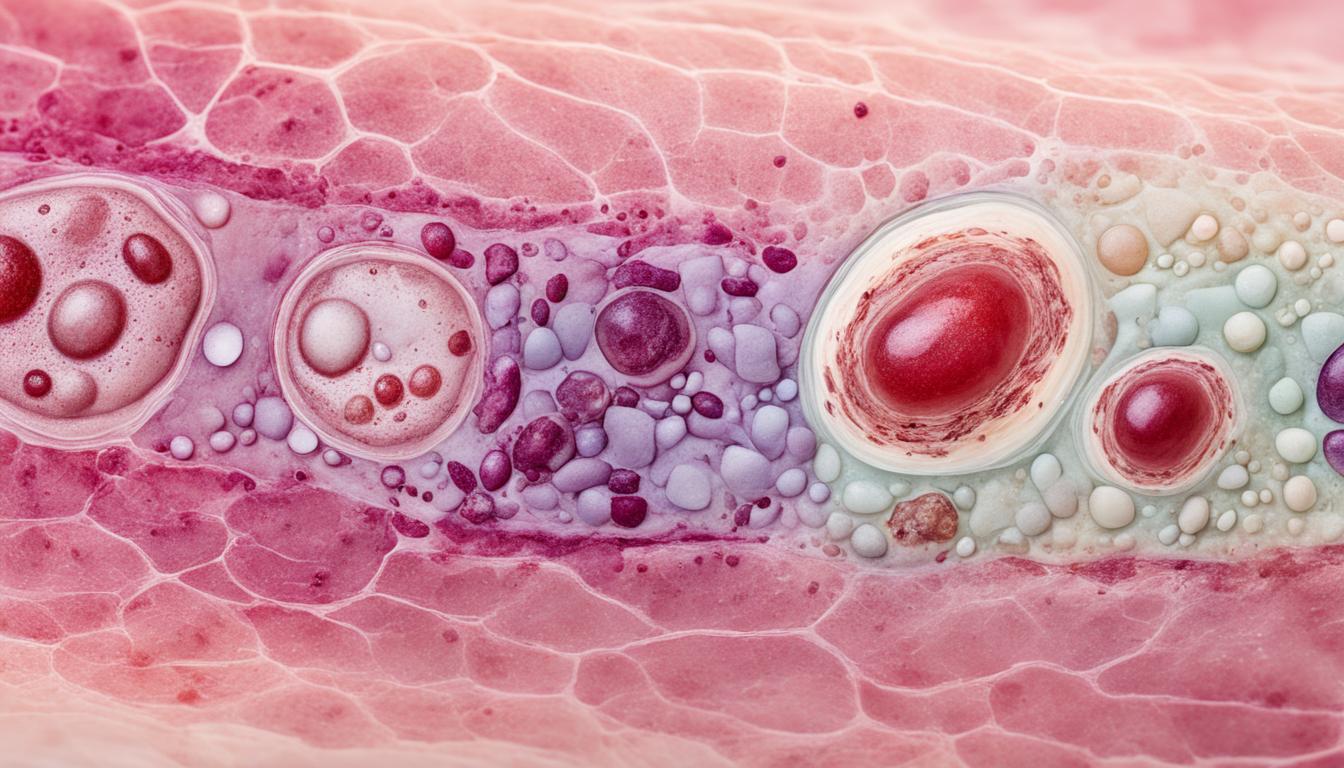Epidermolysis bullosa (EB) is a rare genetic skin disorder found in about 1 in 50,000 births. It leads to very fragile skin, causing blisters and sores with even minor touch. Many call it a rare skin condition, blistering disorder, or a skin fragility problem.
In EB, there are several types like EB Simplex and Dystrophic EB. Each type varies in its effects and seriousness. This disorder not only impacts the skin but also other parts like the throat and urinary tract. Sometimes, it can even cause severe diseases and raise the chance of skin cancers.
Even with ongoing research, there is no cure for EB yet. But, scientists and doctors are looking into ways to help those with EB. Two of these ways are stem cell therapy and gene therapy, which are looking good in tests and research.
Key Takeaways:
- Epidermolysis bullosa (EB) affects about 1 in 50,000 people, making their skin very easy to tear.
- Simple movements can cause these people to get blisters and sores.
- The different types of EB show up in various ways and can involve more than just the skin.
- This disorder can lead to serious health problems and increase the risk of some cancers.
- While there’s no cure for EB now, treatments like stem cell and gene therapy are being studied to help.
Types of Epidermolysis Bullosa and Their Characteristics
Epidermolysis bullosa (EB) is a rare genetic skin disorder with various types. Each type has its own set of unique characteristics. It’s crucial to understand them for correct diagnosis and managing the condition.
1. EB Simplex
EB Simplex is the most common type. It shows blistering in the basal layer of the skin from minor injuries. The blistering varies in severity. It can mild or frequent and severe.
People with EB Simplex won’t scar or have their fingers and toes fuse. But, they might face discomfort and challenges in daily life. This continues throughout their lives.
2. Junctional EB
Junctional EB is a severe type where the epidermis and dermis separate at the basement membrane. This causes severe blistering and life-threatening issues. It affects not just the skin, but also internal organs. Health challenges include difficulty eating and breathing.
Individuals with Junctional EB need specialized care because of these serious complications. They require ongoing support from healthcare professionals.
3. Dystrophic EB
Dystrophic EB shows blistering beneath the basement membrane, leading to scarring and joint fusion. Some might face limited joint movement. The symptoms’ severity can vary. For those experiencing severe symptoms, managing the condition is more complicated.
Wound care for Dystrophic EB needs to be very detailed. Management of complications is crucial. Rehabilitation may also help improve mobility and limit physical restrictions.
4. Kindler EB
Kindler EB is a rare EB subtype. It causes blistering, skin fragility, and sunlight sensitivity. Individuals may have progressive skin changes. These can include poikiloderma and skin cancer. The eyes, mucous membranes, and internal organs can also be affected.
For Kindler EB, a comprehensive medical care plan is necessary. This plan helps manage symptoms and prevent severe complications. Skin cancer and other life-threatening risks must be addressed.
It’s important for everyone involved to understand the different EB types. Each has its own challenges. Tailored care and support are needed for each type. Research is ongoing. Improvements in treatment and, hopefully, a cure are on the horizon.
Diagnosis, Treatment, and Future Research for Epidermolysis Bullosa
Diagnosing epidermolysis bullosa (EB) involves several steps. A doctor does a physical exam and may order genetic tests. A skin biopsy and immunofluorescence mapping also help make a diagnosis. These tests figure out what type of EB a person has. This is important for planning the right treatment. Although there is no cure for EB, managing symptoms and preventing complications are key.
The goal of treating EB is to reduce pain, stop itching, and help the skin heal. Doctors might recommend medications like pain relievers and ointments. In some severe cases, a surgery could be required. This can fix problems like a narrowed esophagus or fused fingers and toes. Rehabilitation therapy also plays a role. It can make movement easier and help improve life quality.
Scientists are continually studying new future treatments for EB. Some possibilities are stem cell therapy, gene therapy, and protein replacement therapies. These new methods offer hope for a better life for EB patients. Still, more research is needed to prove they are effective and safe. But, these advances might face challenges like being too expensive or hard to get. Despite this, ongoing studies and support from the medical community and EB groups suggest better treatments for EB are on the horizon.

